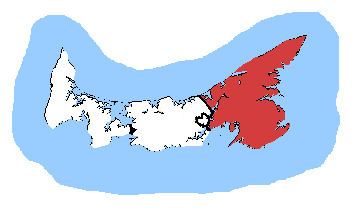First contested 1968 District webpage profile, map Elector 28,777 | District created 1966 Last contested 2015 | |
 | ||
MP Lawrence MacAulayLiberal | ||
Cardigan is a federal electoral district in Prince Edward Island, Canada, that has been represented in the Canadian House of Commons since 1968.
Contents
Demographics
Ethnic groups: 98.5% White, 1.1% Native Canadian
Languages: 97.0% English, 1.2% French, 1.7% Other
Religions: 51.0% Catholic, 40.3% Protestant, 2.6% Other Christian, 5.9% No affiliation
Average income: $22 712
Cardigan is the riding with the highest percentage of people of Scottish (48.2%) and Irish (33.4%) ethnic origin (multiple responses).
Geography
The district includes all of Kings County and eastern Queens County. It also includes Governors Island and Boughton Island.
According to Elections Canada, the geographic boundaries of this riding for the 39th General Election (2006) are:
Consisting of:
(a) the County of Kings;(b) that part of the County of Queens comprised of: lots 35, 36, 37, 48, 49, 50, 57, 58, 60 and 62; the Town of Stratford; and(c) Governors Island and all other islands adjacent to the County of Kings and to the above-mentioned lots.See the map of Cardigan riding.
Political geography
In the 2008 election, every poll except two voted Liberal. The only two polls that didn't, voted Conservative. These two polls were centred in the town of Georgetown, Prince Edward Island. [1]
History
The electoral district was created in 1966 from parts of the ridings of King's and Queen's, with minor modifications to its boundaries since. The boundaries of this electoral district will stay unchanged for the 2012 federal electoral redistribution.
Members of Parliament
This riding has elected the following Members of Parliament:
2011 election
In 2011, a Student Vote was conducted at participating Canadian schools to parallel the 2011 Canadian federal election results. The vote was designed to educate students and simulate the electoral process for persons who have not yet reached the legal majority. Schools with a large student body that reside in another electoral district had the option to vote for candidates outside of the electoral district then where they were physically located.
